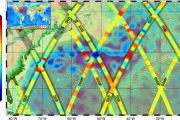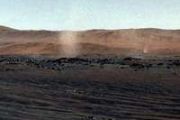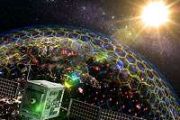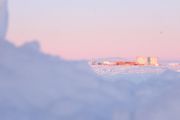
Copernical Team
CASC plans more than 40 space launches for China in 2022
 China Aerospace Science and Technology Corp, the country's major space contractor, plans to carry out more than 40 space launch missions this year, according to its annual work report.
Among the scheduled launches, the most important ones will be the six related to the Tiangong space station program, according to the report delivered by Xu Qiang, general manager of the State-owned space co
China Aerospace Science and Technology Corp, the country's major space contractor, plans to carry out more than 40 space launch missions this year, according to its annual work report.
Among the scheduled launches, the most important ones will be the six related to the Tiangong space station program, according to the report delivered by Xu Qiang, general manager of the State-owned space co China to complete building of space station in 2022
 China will complete the building of its space station in 2022, according to the China Aerospace Science and Technology Corporation.
The country will see 40-plus space launches in 2022, including multiple manned space flights, the company said at a recent conference on its plan for the new year.
It plans to launch two cargo craft, two Shenzhou spaceships and two laboratory modules of
China will complete the building of its space station in 2022, according to the China Aerospace Science and Technology Corporation.
The country will see 40-plus space launches in 2022, including multiple manned space flights, the company said at a recent conference on its plan for the new year.
It plans to launch two cargo craft, two Shenzhou spaceships and two laboratory modules of Matter and antimatter seem to respond equally to gravity
 As part of an experiment to measure-to an extremely precise degree-the charge-to-mass ratios of protons and antiprotons, the RIKEN-led BASE collaboration at CERN, Geneva, Switzerland, has found that, within the uncertainty of the experiment, matter and antimatter respond to gravity in the same way.
Matter and antimatter create some of the most interesting problems in physics today. They ar
As part of an experiment to measure-to an extremely precise degree-the charge-to-mass ratios of protons and antiprotons, the RIKEN-led BASE collaboration at CERN, Geneva, Switzerland, has found that, within the uncertainty of the experiment, matter and antimatter respond to gravity in the same way.
Matter and antimatter create some of the most interesting problems in physics today. They ar Callisto Technology Demonstration to Fly Aboard Orion for Artemis I
 Flying on NASA's Orion spacecraft during the uncrewed Artemis I mission will be Callisto, a technology demonstration developed through a reimbursable space act agreement with Lockheed Martin. Lockheed Martin has partnered with Amazon, and Cisco to bring the Alexa digital assistant and Webex video collaboration aboard Orion's first flight test in deep space.
Named after a mythological Greek
Flying on NASA's Orion spacecraft during the uncrewed Artemis I mission will be Callisto, a technology demonstration developed through a reimbursable space act agreement with Lockheed Martin. Lockheed Martin has partnered with Amazon, and Cisco to bring the Alexa digital assistant and Webex video collaboration aboard Orion's first flight test in deep space.
Named after a mythological Greek China will continue to 'modernise' nuclear arsenal: foreign ministry
 China Tuesday said it will continue to "modernise" its nuclear arsenal and called on the United States and Russia to reduce their stockpiles a day after global powers pledged to prevent such weapons spreading.
In a rare joint statement setting aside rising West-East tensions, the United States, China, Russia, Britain and France reaffirmed their goal of creating a world free of atomic weapons
China Tuesday said it will continue to "modernise" its nuclear arsenal and called on the United States and Russia to reduce their stockpiles a day after global powers pledged to prevent such weapons spreading.
In a rare joint statement setting aside rising West-East tensions, the United States, China, Russia, Britain and France reaffirmed their goal of creating a world free of atomic weapons IBCS connects the Joint Force, enabling effects across all domains
 Northrop Grumman was awarded a five-year contract valued at more than $1 billion from the U.S. Army for low-rate initial production and full-rate production of the Integrated Battle Command System (IBCS) on December 23.
"IBCS is a centerpiece of the U.S. Army's modernization strategy for air and missile defense to address the changing battlefield," said Mary Petryszyn, corporate vice presi
Northrop Grumman was awarded a five-year contract valued at more than $1 billion from the U.S. Army for low-rate initial production and full-rate production of the Integrated Battle Command System (IBCS) on December 23.
"IBCS is a centerpiece of the U.S. Army's modernization strategy for air and missile defense to address the changing battlefield," said Mary Petryszyn, corporate vice presi North Korea fires suspected ballistic missile into sea
 North Korea fired what appeared to be a ballistic missile into the sea on Wednesday, South Korea and Japan said, in the first such launch by Pyongyang this year.
In the decade since Kim Jong Un took power, North Korea has made rapid progress in its military technology at the cost of international sanctions.
The nuclear-armed nation's first apparent weapons launch of 2022 follows a year o
North Korea fired what appeared to be a ballistic missile into the sea on Wednesday, South Korea and Japan said, in the first such launch by Pyongyang this year.
In the decade since Kim Jong Un took power, North Korea has made rapid progress in its military technology at the cost of international sanctions.
The nuclear-armed nation's first apparent weapons launch of 2022 follows a year o Helping to make nuclear fusion a reality
 Up until she served in the Peace Corps in Malawi, Rachel Bielajew was open to a career reboot. Having studied nuclear engineering as an undergraduate at the University of Michigan at Ann Arbor, graduate school had been on her mind. But seeing the drastic impacts of climate change play out in real-time in Malawi - the lives of the country's subsistence farmers swing wildly, depending on the rains
Up until she served in the Peace Corps in Malawi, Rachel Bielajew was open to a career reboot. Having studied nuclear engineering as an undergraduate at the University of Michigan at Ann Arbor, graduate school had been on her mind. But seeing the drastic impacts of climate change play out in real-time in Malawi - the lives of the country's subsistence farmers swing wildly, depending on the rains Supernovae and life on Earth appears closely connected
 Evidence demonstrates a close connection between the fraction of organic matter buried in sediments and changes in supernovae occurrence. This correlation is apparent during the last 3.5 billion years and in closer detail over the previous 500 million years.
The correlation indicates that supernovae have set essential conditions under which life on Earth had to exist. This is concluded in
Evidence demonstrates a close connection between the fraction of organic matter buried in sediments and changes in supernovae occurrence. This correlation is apparent during the last 3.5 billion years and in closer detail over the previous 500 million years.
The correlation indicates that supernovae have set essential conditions under which life on Earth had to exist. This is concluded in Rogozin says Baikonur security strengthened amid Kazakhstan protests
 The Russian forces have strengthened armed protection over the Baikonur Cosmodrome's key objects amid rallies in Kazakhstan, Russian State Space Corporation Roscosmos Head Dmitry Rogozin said on Wednesday.
Rogozin noted that the situation at the Baikonur Cosmodrome is calm as "Roscosmos' branches, law enforcement bodies, city services and organizations are working in the routine mode."
The Russian forces have strengthened armed protection over the Baikonur Cosmodrome's key objects amid rallies in Kazakhstan, Russian State Space Corporation Roscosmos Head Dmitry Rogozin said on Wednesday.
Rogozin noted that the situation at the Baikonur Cosmodrome is calm as "Roscosmos' branches, law enforcement bodies, city services and organizations are working in the routine mode." 



























